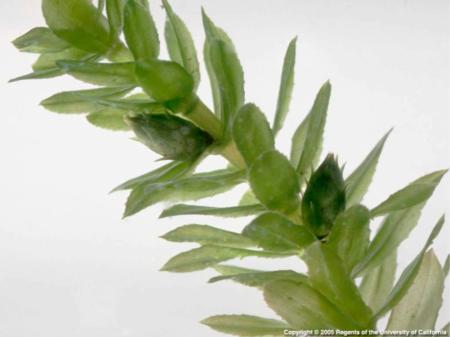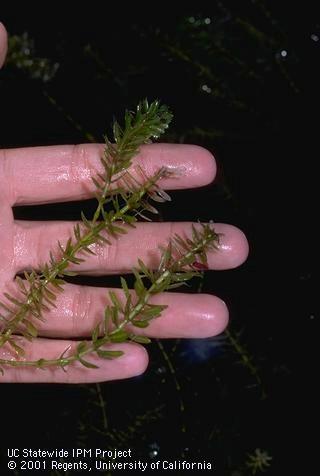Hydrilla
-
Scientific Name
Hydrilla verticillata - Visit ITIS for full scientific classification.
-
Description
 Hydrilla verticillata close-up. Jack Kelly. © 2005 Regents, University of California
Hydrilla verticillata close-up. Jack Kelly. © 2005 Regents, University of California Hydrilla verticillata. Jack Kelly. UC Statewide IPM Project © 2001 Regents, University of California
Hydrilla verticillata. Jack Kelly. UC Statewide IPM Project © 2001 Regents, University of California- Submerged waterweed forms dense mats.
- Has long stems, single white flowers (3 petals) at water surface.
- Leaves are smooth and narrow, with teeth on edges and no stalks, placed in groups along stems.
- Looks like Egeria except that upper and middle leaves are 1/4" - 3/4" long.
- Often has 5 leaves per group.
- The similar Elodea often has 3 leaves per group.
-
Habitat
- Still or slow-moving, freshwater habitats with high nutrient levels.
- Tolerates low light, low salinity, turbidity and pollution.
- Can survive near freezing temperature.
-
Invasion Pathways and Distribution
- Native to warm areas of Asia (and maybe central Africa).
- Now occurs in tropical and temperate areas worldwide.
- It has been eradicated in many areas of California but still occurs in many other areas.
-
Life History
- In U.S. plants may produce pollen and seed bearing flowers or only seed bearing flowers.
- Can grow and infest from pieces.
- Special tubers overwinter in mud and stems form special overwintering buds called turions.
-
Impacts
- Aggressively invades new areas, displacing other plants and changing aquatic ecosystems.
- Forms dense, submerged mats that reduce water flow, interfere with boating and fishing, and clog pumps needed for irrigation, water supply, and flood control.
-
References and Useful Links
For references by category and links to other useful AIS sites see our LEARN MORE page.


